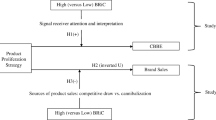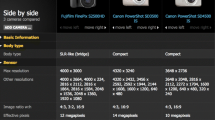Abstract
Manufacturers often try and persuade retailers that their product tends to be included in the higher value baskets by comparing the average value of the baskets containing their brand, the Brand Basket Mean, with the average value of all the baskets in the store. Surprisingly, this comparison is positive for almost all brands and so can be very misleading. As a much more appropriate comparison measure, we propose a Brand Specific Effect, which uses an easy-to calculate, weighted average of all Brand Basket Means as a comparison standard. We then propose a meaningful decomposition of this Brand Specific Effect into Price and Quantity Effects that measure a brand's tendency to be included with expensive items and it's tendency to be included with many items.
Similar content being viewed by others
References
Ainslie, Andrew, and Peter E. Rossi. (1998). “Similarities in Choice Behavior Across Product Categories,” Marketing Science, 17(2), 91–106.
Broniarczyk, Susan, Wayne Hoyer, and Leigh McAlister. (1998). “Consumers' Perceptions of Category Assortment: The Impact of Number of Item and Heuristics,” Journal of Marketing Research, 35 (May), 166–176.
Dunn, R., Reader, S., and Wrigley, N. (1983). “An Investigation of the Assumptions of the NBC Model as Applied to Purchasing at Individual Stores,” Applied Statistics, 32(3), 249–259.
Frisbie, Gil A., Jr. (1980). “Ehrenberg's Negative Binomial Model Applied to Grocery Store Trips,” Journal of Marketing Research, XVII (August), 385–390.
Kahn, Barbara E., and David C. Schmittlein. (1989). “Shopping Trip Behavior: An Empirical Investigation,” Marketing Letters, 1(1), 55–69.
Kim, Byung-Do, and Kannan Srinivasan. (1995). Investigation of Consumer's Price Sensitivity Across Multiple Product Categories: An Empirical Investigation, Working Paper. GSIA: Carnegie Mellon University, Pittsburgh, PA.
Kollat, David T., and Ronald P. Willett. (1967). “Customer Impulse Purchasing Behavior,” Journal of Marketing Research, IV (February), 21–31.
Manchanda, Puneet, Asim Ansari, and Sunil Gupta. (1999). “The 'shopping Basket': A Model for Multi-Category Purchase Incidence Decisions,” Marketing Science, 1999.
Manchanda, Puneet, and Sunil Gupta. (1999). Complementarity in Shopping Baskets: Investigating Multi-Category Purchase Incidence and Brand Choice. University of Chicago working paper (March).
McKay, D. B. (1973). “A Spectral Analysis of the Frequency of Supermarket Visits,” Journal of Marketing Research, 10 (February), 84–90.
Rao, Srikumar S. (1998). “Diaper-beer Syndrome,” Forbes, 6 (April), 128–130.
Author information
Authors and Affiliations
Rights and permissions
About this article
Cite this article
Chien, YH., George, E.I. & McAlister, L. Measuring a Brand's Tendency to be Included in High Value Baskets. Marketing Letters 12, 287–298 (2001). https://doi.org/10.1023/A:1012221303960
Issue Date:
DOI: https://doi.org/10.1023/A:1012221303960




